The Land of the Rising Sun from Mt. Fuji
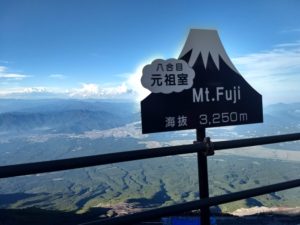
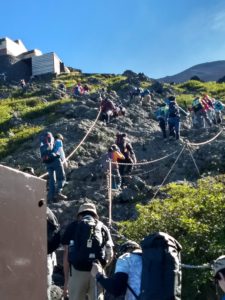 I read everything I could about Fuji but the weather was the determinant. I was staying in Tokyo for almost 3 weeks so I hoped there would be a good weather window. The weather was actually quite nice, so I planned to go on a Sunday to Monday, in hopes that there would be slightly less pilgrims than a Saturday. There were still thousands of people, but I was able to have a few moments to myself when traffic started to thin around the 7th station. Fujisan is broken into 10 stations, and most people start at the last bus stop at the 5th station.
I read everything I could about Fuji but the weather was the determinant. I was staying in Tokyo for almost 3 weeks so I hoped there would be a good weather window. The weather was actually quite nice, so I planned to go on a Sunday to Monday, in hopes that there would be slightly less pilgrims than a Saturday. There were still thousands of people, but I was able to have a few moments to myself when traffic started to thin around the 7th station. Fujisan is broken into 10 stations, and most people start at the last bus stop at the 5th station.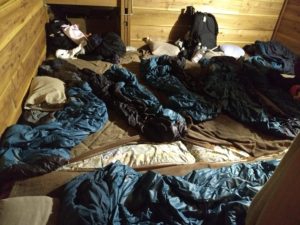
Like giant bunk beds, you had to duck as there was a layer of hikers sleeping above you. Many heads were bumped.
It only took me four hours to get to the hut via the popular Yoshida trail. I thought it would be 5-6 so I was surprised when I came up a switch back and there I was at Tomoekan, my hut at the 8th station. Since it was only 5pm I had some time to relax. I watched an amazing sunset and tried to sleep. At 10pm I still wasn’t asleep so I walked outside and watched a spectacular lightening storm in the clouds straight ahead. When I got back to Tokyo, I heard they had a wild thunderstorm. I think I finally slept a couple hours before my alarm went off at 2am. A lot of people were already geared up, but I lolly gagged because the trail sign said it was only 80 minutes to the top, and sunrise was at 5:15am.
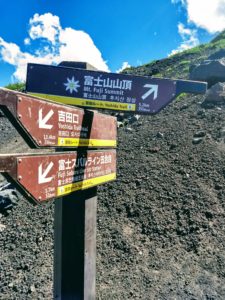
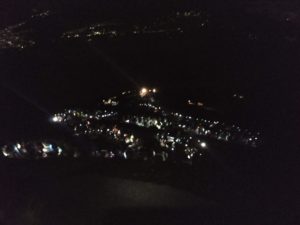
The string of lights are hikers’ headlamps.
At 4:45am, I finally crossed the last torii gate that signaled the summit. That last 80 minutes actually took over two hours! The sky was just firing up and the excitement was palpable. I found a spot to sit and take pictures, and give thanks.
After a while I walked the trail along the summit which took me to the highest point on Fuji and I saw the full moon setting. It was exactly what I wanted it to be.
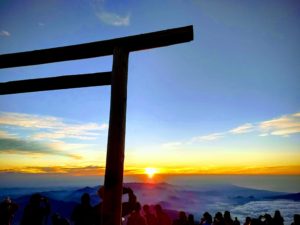
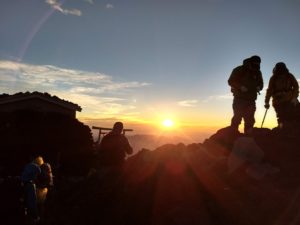
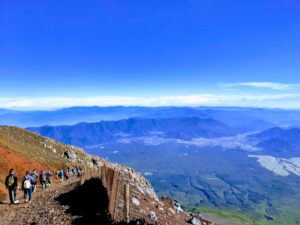
Finally close to the 6th station it started to flatten out a bit. I walked into the helmet rental hut and showed them my arm and said “Band-aid?”. They put some antiseptic on me (which is what I really wanted since I was covered in dust) and bandaged me up. I was happy again.
As I’m getting on the bus, it’s a 2.5hr trip back to Tokyo, a guy walks by wearing a Jack’s Generic shirt, a local Austin triathlon. And of course he’s from Austin but living in Tokyo now! Most of the people I’d seen in Fuji were Asians, but I wasn’t so surprised to see an Austinite, it’s a small world after all.
Tips:
- Take lots of cash for water, food snacks, postcards, and souvenirs.
- The bathrooms costs 200Y each, so bring coins as there’s no change available.
- Buy postcards and international stamps at the 5th station, and mail them at the post office at that station. You can also buy post cards at the mountain huts.
- There’s a website to help English speakers book mountain huts on the 7th station for an extra 1000Y. I missed the three day cutoff for that website, but was able to easily book myself for the 8th station and didn’t have to pay in advance.
- Take Band-Aids, or tape up your feet. They’ll take a pounding on the way down, or you may fall on jagged lava rocks.
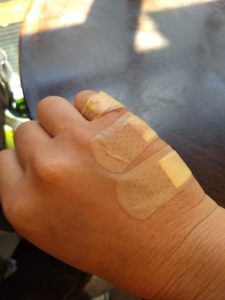
The Old and New Capitals of Japan
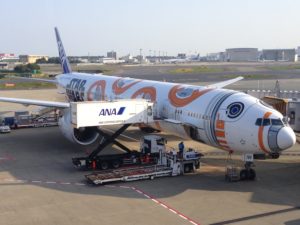
The force was with me.
Tokyo
It wasn’t until I stepped off the train and couldn’t read anything, that I thought, “How did I get here?”. But that’s what happens when you tell me you are going somewhere interesting. So be warned – I invite myself along. To be fair, I did give my sweet co-worker, Lynda, a chance to say no, and made her ask her sister, who was traveling with her, if it was okay. But I jumped at the chance to burn my last two weeks of PTO visiting Asia.
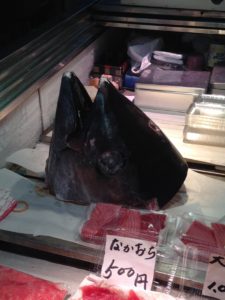
Tuna head in the fish market.
So, there I was – wishing I’d at least attempted to learn a few helpful phrases, but it was too late now. Fortunately, I had the address to my AirBnB written in English and Japanese, because I definitely got lost my first ten minutes of getting off the train. Turns out, this would happen many more times in the next five days.
For my first day in Tokyo, I booked a bike tour around the bay. I love being on bikes, but it’s also a good way to see a lot when you have limited time. It’s also nice to have a tour guide answer all my cultural questions, like where can I dress up like Mario and drive a go-kart around Tokyo? (It’s a real thing.) We visited some shrines, temples and the fish market, which is everything you’d image including tuna heads that weigh more than I do!
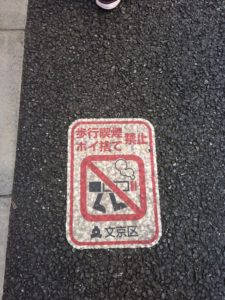
The following day, I decided to get out of the city. I took a train about an hour outside of Tokyo to Mount Takao. I wanted to go where the Japanese go to get away from it all, and I knew I was on to something when I was the only foreigner on that train. There was a helpful English pocket guide and info desk that explained the six different trails and other things I could find at the top, like a temple and some food. The most popular trail is a paved walkway suitable for anyone, but I chose a more remote trail. Each path has an estimated time from 30-110 minutes, and there’s even a chair lift to make it more accessible. It was a steep, beautiful autumn climb, and I was lucky to be able to see Mt. Fuji from the top despite the clouds. After a few hours hiking, I walked over to the Trick Art Museum across from the train station. I’d highly recommended going with one or two friends to take fun photos, but I still had fun by myself.
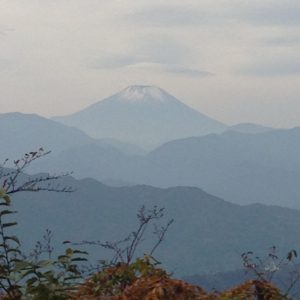
View of Mt. Fuji from Mt. Takao on a partly cloudy day.
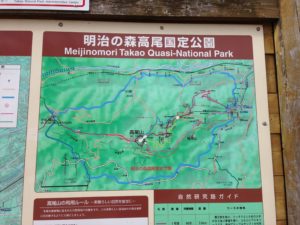
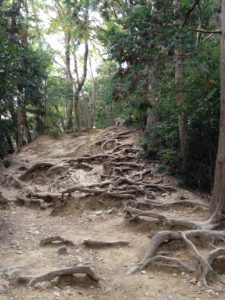
We spent our last night in Tokyo at a capsule hotel, which is a unique experience. I didn’t feel claustrophobic because the capsule was much taller than I expected, but even t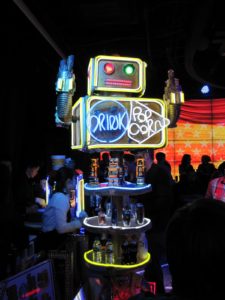
hough you have a locker, there isn’t much space. It did have a double locked women’s only floor with free amenities, a robe, slippers and blowdryers. It was good for one night, but I was happy to move on the next day. We went to the nearby Anthony Bourdain visited Robot Restaurant, which is like a dinner show without the dinner and if you’d walked into the worst hotel in Las Vegas, and were on drugs. Some might disagree, but for me it was a total waste of $66 to watch pandas, samurais, maybe a dinosaur dance around the stage to a loosely based story about trying to stop robots from taking over the Earth. I didn’t get it.
Kyoto
The next day we took the shinkansen bullet train to Kyoto, and stayed at another AirBnB. The house was over 60 years with low doorways, lots of windows, and tatami mats (which are suprisingly comfortable). We wanted the traditional Japanese living experience, but we had to keep reminding each other to take off our shoes in the house. Wooden blocky sandals were provided, but for me they were too big and difficult to walk around in.
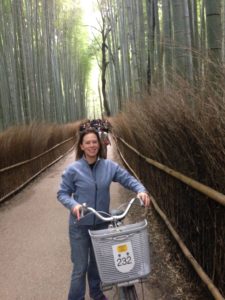
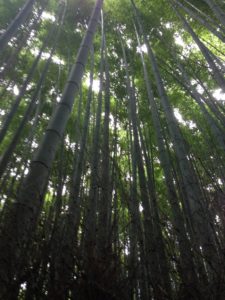
In Kyoto, I most wanted to visit the bamboo grove in Arashiyama. There was a lot we wanted to see, so after getting off the train, we rented bikes for the day (~$10). Did I mention I love riding bikes? I didn’t realize how touristy this area would be, but the exploding fall colors demanded an audience. There are a number of temples, but many cost a few dollars, and since we’d already been to a few for free we opted out. You could spend days just in this district. There’s a monkey park, a lake for boating and fishing, large temples, restaurants, and of course the grove path. We were told we couldn’t bike through a section of the grove, and we couldn’t even if we wanted to because there was so many people, and a number of rickshaws pulling visitors – it was like a strong man competition! After we got through the crowded part, we were able to bike again and it was perfect. I’d guess the path is a mile or two, so the bikes were a good idea.
I also wanted to visit the Fushimi-Inari-Taisha Shrine after seeing beautiful pictures of the torii gates, so we left Arashiyama although we could have stayed the whole day. There are large signs announcing the shrine’s #1 Trip Advisor status for foreign visitors or something similar to greet you, and once we entered I understood why. All of the information at most of the shrines we visited are in Japanese, so while we could appreciate the beauty, we largely didn’t know the details. The Fushimi-Inari had handy QR codes in multiple languages with lots of info. This makes a world of difference if you are interested in knowing the history and significance of everything. We followed the never-ending path beneath to orange torii gates, which get replaced with bigger and bigger gates as one’s prayers are answered. I say never-ending because we walked up and up for maybe two hours, and still not even close to the top, and since it was already dark we turned around.
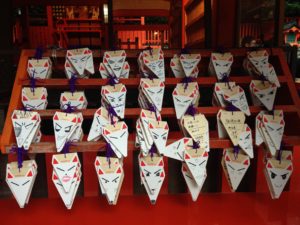
Prayer placards at Fushimi-Inari.
Our last day in Kyoto was basically spent getting back to the Tokyo airport. I took the metro to the shinkansen to Tokyo, and then to the Narita Express to the airport. The 50 minute Narita express is a great way to get to the airport from the city, but it only runs every 30 minutes, and while the trains run regularly we still barely made our flight. I got sidetracked looking for souvenirs in the Pokemon shop.
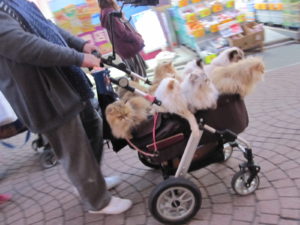
Eight kittens in a stroller. Just a regular day on Takeshita Street.
Japan, in general
Ooooh, the FOOD. While my knowledge of Japanese cuisine is limited, I was most looking forward to the food. And I wasn’t disappointed, except that when I left I realized I never even ate sushi! My favorite meals were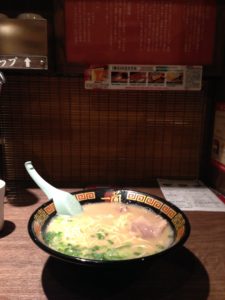
the shabu-shabu, and the ramen. The meals were all a lot of fun because they were more communal, except for the ramen. We decided to find a 24-hour ramen place for breakfast one day. After walking around lost for 30 minutes and asking many people, we finally found the tiny door that took us down some stairs. There we found a small vending machine with pictures of bowls of ramen. We selected the bowl we wanted and the machine spit out a ticket. We sat at a bar with little walls that separated you from the person sitting next to you. You can take these down, but we didn’t figure that out until we were leaving. The screen in front of me lifted up and all I saw were a pair of hands take my ticket. I filled out a form to select how much spice, fat (oil, I think it meant), flavor etc. and handed that to the hands, and then the screen dropped. It only opened again to deliver our bowls. We also ate yakatori, Japanese BBQ, curry, soba noodles, and many things I don’t know what they were. There just weren’t enough meals for all the things I wanted to eat.
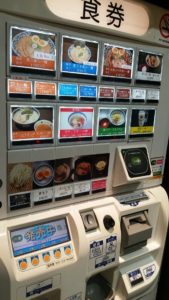
Ramen vending machine. Photo credit – Kathy Tran
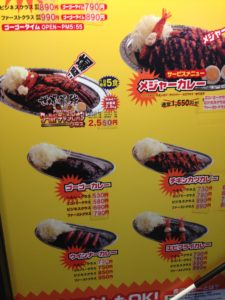
I can’t tell what these dishes are or what the difference is between them.
But it was the culture and people I found most interesting. The people are orderly, rule-followers, and concerned with not offending others. They don’t talk on their cell phones on the trains, and they don’t jay walk. They let you browse their shops without question and they are kind and helpful when asked. A stark contrast to what I’d left in the US in the wake of the election. Even during rush hour on the train, or on a busy shopping street, there was a calmness – it was safe. I never felt threatened, even when obviously looking like a lost female tourist – no one ever approached me – I had to seek out the help I wanted. And the country itself is extremely clean. But the most interesting thing is they don’t like dragon back tattoos (possibly this sign means any tattoo, but specifically dragons). 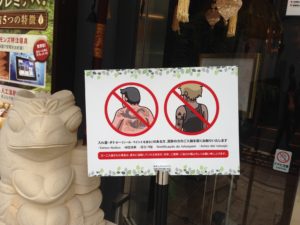
To be continued in Singapore…
Tips:
- Get a pocket wifi. But know that even if you do and use Google maps – you may still get lost (or maybe that’s just me). But that’s ok, it’s part of the fun.
- Buy a JR pass before you go. It was well worth it if you plan to travel to other cities.
- Stay near the sights you want to see, so you don’t spend all your time on the metro.
- Yes, the flight is long (about 14 hours from Houston to Tokyo). Go anyway.
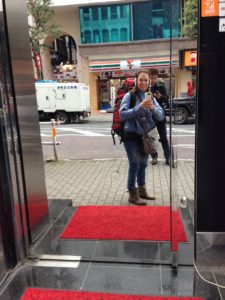
This is me lost. Also, there’s lots of 7-11s.